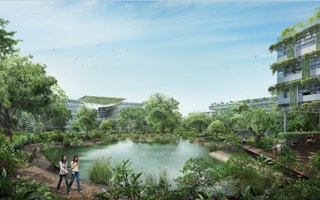Employees working at Singapore’s new CleanTech business district may soon be sighting local pangolins as part of their daily routine, thanks to an award-winning park built by Singapore’s industrial property developer JTC Corporation.
JTC announced Monday that it won three separate green building awards from Singapore’s Building and Construction Authority (BCA), including the first ever Platinum Award for a new parks scheme, developed to encourage innovative, sustainable development of civic landscape areas.
The award is a joint initiative between BCA and Singapore’s National Parks Board (NParks) and JTC has won the top gong for this award for its “Green Core” - a park that is integrated with the buildings of its CleanTech Park.
BCA’s director of technology development Tan Tian Chong said the agency hopes “this will set a new benchmark for future parks to be developed in Singapore.”
JTC’s Green Core, located at the 50 hectare CleanTech Park under development at Nanyang Avenue, will act as a recreation space and pedestrian network within the industrial park. It is also designed to preserve the biodiversity of the area and will act as a green corridor that allows the area’s wildlife, including the native Sunda Pangolin and harlequin butterflies, to move safely between connected natural areas.
The designers chose to incorporate a rare tropical freshwater wetland forest - based on a biodiversity impact assessment - that will include endangered tree species native to Singapore. These species, combined with fruit and nectar-producing plants, are expected to attract wildlife back into the park after development. JTC will plant more than 100 per cent of the trees removed for development.
Singapore’s CleanTech Park is designed to protect habitat for wildlife such as the Sunda Pangolin. Photo: vulkaner.no
Incorporating biodiversity in urban development planning is not new to Singapore. Last November, the city-state launched its Singapore Index on Cities’ Biodiversity, a tool adopted by over 30 cities to measure conservation efforts and identify areas for improvement.
Other design elements of the five hectare park include property-wide rain water capture and filtration using natural materials. The resulting treated water will be combined with greywater from the site’s buildings and recycled to fill an estimated 38 per cent of the development’s non-potable water requirements.
The project developers say the Green Core is meant to bring the community closer to nature, and remind them of the “fundamental tenets of their vocation in this industry.”
This refers to the clean-tech industries to be housed at CleanTech Park, a business park conceptualized by JTC and EDB, which will serve as a ‘living lab’ for the test-bedding and development of green technologies and sustainable urban solutions in Singapore.
CleanTech Park’s first multi-tenanted building, CleanTech One, also won a platinum award from BCA in the category of Non-Residential New Buildings.
The six storey building, to be completed at the end of this year, will house laboratories and feature eco-friendly technologies such as a 1MW(megawatt) hydrogen fuel cell plant that uses horticulture waste, and solar power generation from photovoltaics integrated into the building structure.
Using passive design features, such as natural ventilation, rooftop gardens and multiple shade features, JTC said it has reduced the development’s estimated energy needs. Combined with energy efficient technologies such as LED lighting, these features are predicted to provide energy savings of 50 per cent.
Other sustainability features of the project include the use of environmentally-friendly building materials and construction practices, waste reduction and recycling, on-site food waste treatment, and an advanced building monitoring system to monitor the building’s environmental performance.
JTC chief executive Manohar Khiatani said, “Achieving these Green Mark rankings is a testament to JTC’s growing commitment to environmental sustainability. Given the global trend towards sustainable growth, JTC is stepping up its efforts to address environmental challenges but in a practical and cost effective manner.”
In another first for JTC, it’s Mediapolis development became the first multi-developer project to win the BCA’s district level Green Mark Award.
JTC’s Mediapolis is a 19 hectare project located at One-North that will house state-of-the-art media facilities and related research labs, as well as offices, serviced apartments and hotels. It is slated for completion in 2020.
The BCA granted GoldPlus status to the project based on its green masterplan that incorporates environmentally sustainable urban planning concepts to ensure that green building standards are adhered to across the various development plots and infrastructure within the district.
The developers in Mediapolis will be issued a Developers Green Handbook which will set guidelines on energy efficiency; water efficiency; waste-management and environmental protection on a building level. All developments within the district must achieve at least a Gold level BCA Green Mark certification.
JTC said it has set its sights on attaining a district level Green Mark award for CleanTech Park as well.
According to BCA, it’s on the right track. Mr Tan praised the project for integrating environmental principles right from day one.
“JTC has demonstrated tremendous green building leadership in taking an overall sustainability approach in developing the masterplan for their projects,” he added.
That can only be good news for the pangolins.










